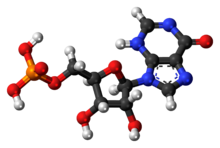Inosinic acid
This articleneeds additional citations forverification.(November 2014) |

| |

| |
| Names | |
|---|---|
| IUPAC name
5'-Inosinic acid
| |
Other names
| |
| Identifiers | |
3D model (JSmol)
|
|
| ChEBI | |
| ChEMBL | |
| ChemSpider | |
| ECHA InfoCard | 100.004.588 |
| E number | E630(flavour enhancer) |
| MeSH | Inosine+monophosphate |
PubChemCID
|
|
| UNII | |
CompTox Dashboard(EPA)
|
|
| |
| |
| Properties | |
| C10H13N4O8P | |
| Molar mass | 348.208g·mol−1 |
Except where otherwise noted, data are given for materials in theirstandard state(at 25 °C [77 °F], 100 kPa).
| |
Inosinic acidorinosine monophosphate(IMP) is anucleotide(that is, anucleosidemonophosphate). Widely used as a flavor enhancer, it is typically obtained from chicken byproducts or othermeat industrywaste. Inosinic acid is important inmetabolism.It is theribonucleotideofhypoxanthineand the first nucleotide formed during the synthesis ofpurinenucleotides. It can also be formed by thedeaminationofadenosine monophosphatebyAMP deaminase.It can behydrolysedtoinosine.
The enzyme deoxyribonucleoside triphosphate pyrophosphohydrolase, encoded by YJR069C inSaccharomyces cerevisiaeand containing (d)ITPase and (d)XTPase activities, hydrolyzesinosine triphosphate(ITP) releasingpyrophosphateand IMP.[1]
Important derivatives of inosinic acid include the purine nucleotides found innucleic acidsandadenosine triphosphate,which is used to storechemical energyinmuscleand other tissues.
In the food industry, inosinic acid and itssaltssuch asdisodium inosinateare used asflavor enhancers.It is known asE numberreferenceE630.
Inosinate synthesis
[edit]The inosinate synthesis is complex, beginning with a5-phosphoribosyl-1-pyrophosphate(PRPP).Enzymestaking part in IMP synthesis constitute a multienzyme complex in the cell. Evidence demonstrates that there are multifunctional enzymes, and some of them catalyze non-sequential steps in the pathway.[citation needed]

Synthesis of other purine nucleotides
[edit]Within a few steps inosinate becomesAMPorGMP.[2]Both compounds areRNAnucleotides.[2]AMP differs from inosinate by the replacement of IMP's carbon-6 carbonyl with an amino group. The interconversion of AMP and IMP occurs as part of thepurine nucleotide cycle.[3]GMP is formed by the inosinate oxidation toxanthylate(XMP), and afterwards adds an amino group on carbon 2. Hydrogen acceptor on inosinate oxidation isNAD+.Finally, carbon 2 gains the amino group by spending an ATP molecule (which becomes AMP+2Pi). While AMP synthesis requires GTP, GMP synthesis uses ATP. That difference offers an important regulation possibility.

Regulation of purine nucleotide biosynthesis
[edit]Inosinate and many other molecules inhibit the synthesis of 5-phosphoribosylaminefrom 5-phosphoribosyl-1-pyrophosphate (PRPP), disabling the enzyme that catalyzes the reaction: glutamine-5-phosphoribosyl-1-pyrophosphate-amidotransferase. In other words, when levels of inosinate are high, glutamine-5-phosphoribosyl-1-pyrophosphate-amidotransferase is inhibited, and, as a consequence, inosinate levels decrease. Also, as a result, adenylate and guanylate are not produced, which means that RNA synthesis cannot be completed because of the lack of these two important RNA nucleotides.
Applications
[edit]Inosinic acid can be converted into varioussaltsincludingdisodium inosinate(E631),dipotassium inosinate(E632), andcalcium inosinate(E633). These three compounds are used asflavor enhancersfor the basic tasteumamior savoriness with a comparatively high effectiveness. They are mostly used in soups, sauces, and seasonings for the intensification and balance of the flavor of meat.
See also
[edit]References
[edit]- ^Davies O, Mendes P, Smallbone K, Malys N (2012)."Characterisation of multiple substrate-specific (d)ITP/(d)XTPase and modelling of deaminated purine nucleotide metabolism".BMB Reports.45(4): 259–64.doi:10.5483/BMBRep.2012.45.4.259.PMID22531138.
- ^abMader, M. M.; Henry, J. R. (2007-01-01), Taylor, John B.; Triggle, David J. (eds.),"7.03 - Antimetabolites",Comprehensive Medicinal Chemistry II,Oxford: Elsevier, pp. 55–79,doi:10.1016/b0-08-045044-x/00204-2,ISBN978-0-08-045044-5,retrieved2020-12-17
- ^Voet, D, Voet, J. G., Biochemistry (3rd Edition), John Wiley & Sons, Inc., 2004, pg 1095
Further reading
[edit]- Berg, Jeremy M.;Bioquímica;Editorial Reverté; 6ena edició; Barcelona 2007.
- Nelson, David L.;Principles of biochemistry;Editorial W.H Freeman and Company; 4th edition; New York 2005.
